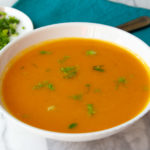This post may contain affiliate links. Please see our disclosure for more information.
The sweet orange flesh of a winter squash holds the promise of rich nutrients, such as vitamins A and C, magnesium, and potassium.
That orange color is beta carotene, a precursor to vitamin A that’s also a fantastic liver tonic.

A strong calling card indeed!
Sweet, astringent and slightly cooling, winter squash pacifies Pitta dosha the most.
Their availability in the fall suggests that squash is exactly what the body most needs at this time.
Fall is the season when the body transitions from the Pitta summer heat into the dry, cold, fall air.
During this time, Pitta needs pacifying, and winter squash will help with that.
Winter squash is heavy
Butternut, acorn, buttercup, and spaghetti squashes, as well as pumpkin, are supportive for most individuals.
The key is to consume these healthy foods in the right quantity, and to cook them properly to ensure digestibility.
From an Ayurvedic perspective, winter squash does require some cautioning.
Vaidya Mishra, founder of SVAyurveda, does not recommend consuming winter squash at all due to its “channel clogging” effect.
He writes that despite the nutrients and nourishment contained in the squash, the absorption of these same nutrients into the bodily tissues may be blocked by the heavy, and difficult to digest qualities of the squash.
Personally, I am not one for wholesale avoidance or rejection of a food. I would rather be aware of this fact, and then find ways to enjoy squash that avoids harm.
This is because everything is about balance and moderation.
I’ll admit that I do find a butternut squash soup heavy and cloyingly sweet.
That’s why I added the lightest, brightest vegetable I could find—fennel root—to my version of butternut squash soup, to lighten it up.
Not all winter squash are alike
The other thing is that not all winter squashes are the same.
Let’s take a look at their similarities and differences.
| Squash Variety | Qualities/Tastes | Balances | Aggravates |
| Spaghetti Squash | dry, light, sweet | Vata, Pitta, Kapha | |
| Butternut Squash | heavy, easy, cold, sweet | Vata, Pitta | Kapha |
| Acorn Squash | dry, heavy, cold, sweet | Vata, Pitta | Kapha |
| Pumpkin | dry, difficult, cold, gooey | Pitta | Kapha, Vata |

Kapha dosha
Notice the Kapha aggravating qualities of most of the squash varieties. This is what Vaidya Mishra is referring to. The heavy quality.
There are options though. Notice how spaghetti squash stands out as an option that balances all types.
For Kapha types, acorn or pumpkin would also be good options, since they are drying and Kapha’s tend to be wet.
The dry quality brings in an element of light quality to counter the heavy.
Just be sure to include ample warmth and stimulation in the form of spices to aid with digestion, and squash will be okay in small quantities for my Kapha’s.
Vata dosha
Vata types can enjoy ample winter squash due to the sweet and nourishing qualities of most type of squash.
They will just want to ensure ample sour taste with their squash so that the astringent and drying qualities of the squash don’t dry them out (since Vata types tend to be dry). The sour taste stimulates digestive secretions.
Vata types will also want to ensure enough pungent and warming tastes are included in the squash dish to counter the cold quality, since Vata types tend to be cold.
Pumpkin in particular is recommended for Vata, since it is very grounding and even sedative. Vata types tend to struggle with anxiety, so pumpkin can be very soothing for Vata.
Try pumpkin with warming spices like cinnamon, clove, nutmeg, and allspice, and see if you can notice these qualities.
Pitta dosha
All the squash varieties are soothing for Pitta types.
Pitta’s also have the digestive strength to handle the difficult digestive qualities of the squash.
Squash recipes



